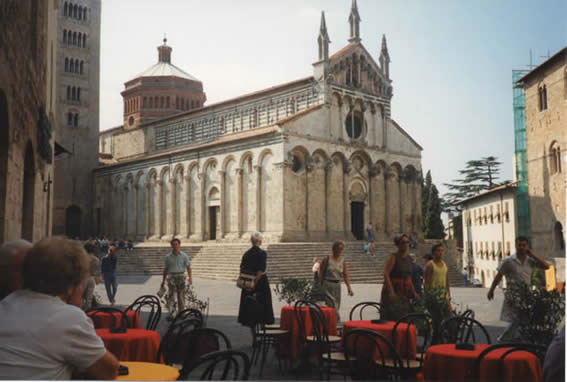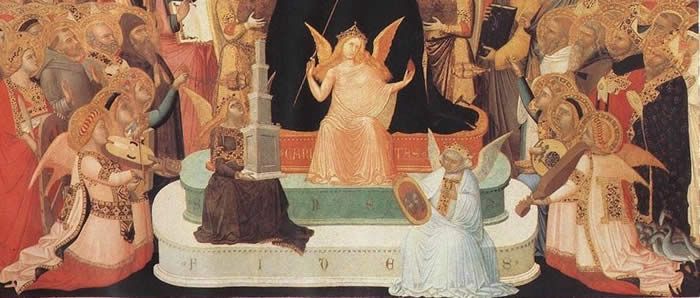INDEX
1. SIENA - MUSEUMS AND PALAZZI
2. SIENA - CHURCHES
3. PLACES WITHIN HALF AN HOUR OF BARONTOLI
6. SIENESE PAINTERS
7. SAINTS IN ART
MASSA MARITTIMA
A beautiful small mediaeval town on the way to the seaside, with one of Italy’s prettiest main squares.
Massa Marittima is divided into an upper and a lower city. The Duomo is in the lower city (città vecchia), which was the original walled town in Romanesque times, but the best museum (Museum of Sacred Art) is in the slightly later upper Gothic city (città nuova). As its name indicates, Massa Marittima (accent on the first i) was once near the coast, overlooking an arm of the sea from its hill-top. But the silting up of the coast changed this and one now has to go another 20 km to Follonica to find the sea.
The hills that Massa stands on are called the Colli Metalliferi or the metal-bearing hills. The city has since Etruscan times been a mining centre, drawing its wealth from copper, silver, lead and iron. The town has a mining museum displaying memories of that past.
The Duomo (Cathedral)

The beautiful Duomo was built in the 11th century in the Pisan Romanesque style with Gothic additions in the 13th century. There is some Sienese stripiness in the higher part of the building, but most of the Duomo is built of a beautiful uniform golden stone. It has a wonderfully sculpted and decorated façade, and a fine campanile with the number of windows increasing towards the top in the Lombard style.
The Duomo is dedicated to St Cerbone, the local saint. He was born in Africa in 493, but moved to Populonia, a major Etruscan town near what is now Piombino, on the coast. He became its Bishop and set about converting the Maremma (as the surrounding region is known). He was accused of heresy, however, and papal messengers came from Rome to fetch him to answer the charges against him. He treated the messengers well, feeding them does’ milk, and went with them to Rome, accompanied by a gaggle of pious geese. When he arrived before the Pope, the geese miraculously appeared at his feet as a testament of his innocence. Having successfully refuted the charges against him, he faced another trial, being thrown to the bears by King Totila of the Goths, but the bears refused to eat him. St Cerbone was clearly afraid that he was not going to be so lucky a third time, as when the Lombard invaders arrived in that part of Italy, he promptly withdrew out of their way to Elba, where he died. Scenes from his life are depicted in the low relief above the main door of the Duomo.
Inside, the Duomo is equally attractive, basilica-shaped, with the minimum of vulgar modern intrusions. It is dotted with charming fragments of mainly 14th century frescoes, but its chief delights are its sculptures and its possible Duccio.
Behind the entrance on the left wall, there is a 3rd century Roman sarcophagus with winged figures in distinctly flirtatious rather than religious mode; note the two couples at either end. On the other side of the entrance door, the fresco representing the Three Kings is a rather splendid affair.
The chapels on the left of the main altar contain both a fine painted wooden crucifix by the Sienese painter Segna di Bonaventura (1298-1331) and a beautiful if rather damaged and green-faced ‘Virgin of the Graces’, dated 1318 and possibly by Duccio.
The main altar itself is a fine piece of Baroque (1626) in ‘giallo di Siena’, a yellow marble that is only found near Siena, that fits in surprisingly well with the rest of the church. Behind it is the tomb of St Cerbone, sculpted and (unusually) signed and dated by Gori di Gregorio of Siena in 1324. It is decorated with a strip cartoon life of the saint; note especially the does being milked to assuage the thirst of the papal messengers, and the geese first going with the saint to Rome and then materialising around his feet as he confronts the Pope.
On the right of the entrance, there is a huge square font made by Girolamo da Como in 1267 with fine sculpted scenes from the Old and New Testaments; on top, an equally handsome but stylistically quite different fifteenth century tabernacle has been added.
The Piazza
The triangular Piazza in which the Duomo stands is one of the most beautiful in Tuscany. It is well worth sitting a while in one of the cafés to soak up its beauty and that of the Duomo, which stands at an oblique angle to the Piazza, rather like a stage set, enabling one to see at the same time the façade and the side wall with the campanile.
To the right of the Duomo, there is the attractive 13th century Palazzo del Podestà, from which the magistrates of the city operated; many have left their crests on the front of the building (which now houses the museum). The museum within it is of little interest, its only good painting having been removed to the Museum of Sacred Art in 2005. Beyond the Palazzo del Podestà, after an attractive small house, stands the 14th century Palazzo Communale, or town hall, a handsome block of a building with crenellations, slightly marred by one obviously new portion.
The new city (città nuova)
Those who have the energy should now take the steep via Moncini, leading off from the Piazza at the far side from the Duomo, to the higher city (one can also drive up round the outside).
The gateway at the top of the via Moncini is all that is left of the Fortezza dei Senese, the fortress that the Sienese built when they conquered Massa in 1355. The tower on the left as you pass through the gateway is a similar remnant of the fortress built in 1228 by the previous regime, the Fortezza dei Massetani. The Sienese, when they took over, pulled most of it down, rebuilding it to only two-thirds of its original height and constructing a flying bridge across to their own fortress. In good weather, the tower (known as the Torre Candeliere or candlestick tower) is open between 11-13.00 and 17-19.00 daily except Mondays. One can climb up (very steep steps) onto the flying bridge, or higher still onto the belfry on top for a good view of the surrounding countryside. Inside the tower, at the same level as the flying bridge, the works of a clock installed in 1610 can be seen, although they are now non-operational and the clock works by electricity.
Beyond the Torre Candeliere on the left is the mining museum, and further along the same street on the right there is a Gothic (mainly 13th century) church, Sant’ Agostino, with a slightly later cloister alongside. Inside the church there is a single nave unusually combined with a triple apse, but otherwise little of interest.
Museo di Arte Sacra (Museum of Sacred Art)
This is a new museum, only opened in 2005. It is beautifully laid out, but – infuriatingly – the exhibits have yet to be labelled. It is at 36 Corso Diaz, opposite the hotel La Fenice, at the far end of the new city. Opening hours are 10.00-13.00 and 15.00-18.00 daily except Mondays (11.00-13.00 and 15.00-17.00 in winter).
The first room has some rather fascinating bas-reliefs that used to be in the Duomo. They are extremely archaic in style, and debate rages among the experts as to whether they are genuine pre-Romanesque works from the 10th century or some later medieval fantasy. There is a very modern bishop with crosier and mitre on the left hand panel; a row of the twelve Apostles (note St Peter with his key on the right) on the next panel; and finally a stylised but moving representation of the Massacre of the Innocents with Herod looking like a playing-card king, soldiers chopping heads of infants and mothers clutching their children to their skirts.
The second room contains some good 14th century statues of apostles with magnificent beards; statue of a red-faced bishop; a wooden crucifix; and an exquisite 14th century silver and enamel crucifix, the last two possibly by members of the Pisano family.
The third room has by far the best picture in the collection: a Maiestà by Ambrogio di Lorenzetti, dating from around 1330, a wonderfully colourful scene of the Virgin surrounded by angels and saints – including an angel offering flowers at head level and musician angels at the bottom of the Virgin’s throne. The Mother and Child are looking at each other with a close and charming intimacy, faces almost touching. An interesting feature is the way that the angels’ wings make up the sides of the throne. On the steps at the base of the throne, figures are seated representing Faith, Hope and Charity, the last clearly the same lady as Justice in Lorenzetti’s ‘Good and Bad Government’ in the Palazzo Pubblico in Siena. Charity holds a wooden spindle, a sign that the painting may have been commissioned by the wealthy local Wool Guild. It was intended for the Duomo, and St Cerbone and his geese are portrayed on the right. At some point the painting was removed from the Duomo, and it was lost for ages, finally to be found in pieces in the roof of a nearby convent in 1867.

Detail from the Maestà, showing the musical angels and virtues at the foot of the Virgin's throne. Note the geese at bottom right.
There are two rooms upstairs. The first has a motley collection of sculpture, paintings and pottery, of which only the painting on the end wall is worth more than a moment’s glance: it is a stable scene by Pietro degli Oriolo (1458-96), one of the better of the later Sienese painters. The stable is the attractively crumbling romantic ruin that had succeeded the gilded Gothic pavilion as the standard way of depicting Jesus’s birth-place. St Agostino is portrayed on the left with his trademark thin face, and on the right some shepherds peep shyly over the stable wall. The final room has some dimly lit old vestments and illuminated manuscripts.
On to the seaside
From Massa it is an easy drive to Follonica on the coast. There are beaches to the North and South of the town. Those to the South, which stretch for several miles along the road towards Punta Ala, are sandy and shallow and good for children but not serious swimmers. There is a narrow band of pinewood between the road and the beach; it is usually possible to park by an entrance to the pinewood and walk through.
1999 and 2005.